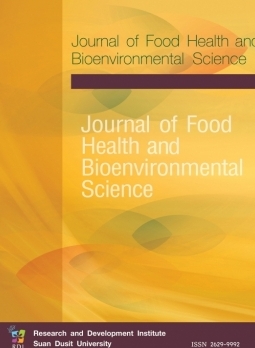Sun Protection of Rice, Gac Fruit and Wood Apple Powders for Developing Face Powder
Keywords:
Face powder, Natural sources, Color, Sun protection factorAbstract
Face powder, in different colors, is used to beautify the skin of the face and neck and make it appear more attractive than natural skin. General characteristics are that it should be fine, soft, easily applied to the skin, long-lasting, disperse well when moist and able to hide wrinkles or dark spots; further, in harmony with the skin color, it should reduce oiliness, have a pleasant smell or color, look natural and not harm the user. We studied the effect of gac fruit and wood apple on color and SPF in face powder containing rice. We examine the natural contents of rice, gac fruit and wood apple in face powder according to the percentage of each recipe. However, the natural extracts were able to absorb UV radiation and used in mixtures with synthetic extracts for sunscreen protection, thus reducing the use of synthetic products. Further, no heavy metals were found in the natural extracts.
References
Balsam, M.S., & Sagarin, E. (1972). Cosmetics: Science and technology (2nd ed.). New York: Wiley-Interscience.
Chucham, N. (2012). Development of face powder containing Thai jasmine rice (Master’s thesis). Chiang Rai: Mae Fah Luang University.
Chuyen, H., Nguyen, M.H., Roach, P.D., Golding, J.B., & Parks, S.E. (2015). Gac fruit (Momordica cochinchinensis Spreng.): A rich source of bioactive compounds and its potential health benefits. International Journal of Food Science & Technology, 50(3), 567-577.
Dutra, E.A., Oliveira, D.A.G.C., Kedor-Hackmann, E.R.M., & Santoro, M.I.R.M. (2004). Determination of sun protection factor (SPF) of sunscreens by ultraviolet spectrophotometry. Brazilian Journal of Pharmaceutical Sciences, 40(3), 381-385.
Gasparro, F.P., Mitchnick, M., & Nash, J.F. (1998). A review of sunscreen safety and efficacy. Photochemistry and photobiology, 68(3), 243-256.
Jarupinthusophon, S., & Anurukvorakun, O. (2021). Development of jasmine rice flour properties as a safe and efficient ingredient for compact powder. Applied Sciences, 11(1), 1-12.
Kabthong, Ng., Chaiwut, Ph., & Pintathong, P. (2015). Development of dragon fruit colorant with rice starch for application in face powder, Veridian E-Journal, Science and Technology Silpakorn University, 2(1), 130-142.
Kumar, R., Arora, S., & Singh, Sh. (2016). Formulation and development of herbal cucumber gel for sunscreen and anti-oxidant activities. World Journal of Pharmacy and Pharmaceutical Sciences, 5(6), 747-758.
Madhu, G.C., Begum, S., Sai, K.B., Baskarla, S., Sheetal, A., Vijayalakshmi, G., & Vaishnavi, E. (2018). Estimation of phytochemicals and sun protection factor (SPF) number in commonly used ethanolic fruit and vegetable extracts. Indo American Journal of Pharmaceutical Sciences, 5(1), 779-782.
Malsawmtluangi, C., Nath, D.K., Jamatia, I., Lianhimgthangi, E.Z., & Pachuau, L. (2013). Determination of sun protection factor (SPF) number of some aqueous herbal extracts. Journal of Applied Pharmaceutical Science, 3(9), 150-161.
Mansur, J.S., Breder, M.N.R., Mansur, M.C.A., & Azulay, R.D. (1986). Determinacao do factor de protecao solar por espectrofotometria. Anais Brasileiros de Dermatologia, 61, 121-124.
Mir, S.A., Bosco, S.J.D., & Sunooj, K.V. (2013). Evaluation of physical properties of rice cultivars grown in the temperature region of India. International Food Research Journal, 20(4), 1521-1527.
Namchot, J., Phasuk, S., & Takolpuckdee, P. (2012). Efficiency of Feronia limonia swingle branch crude extract as antioxidant. In 5th Rajamangala University of Technology National Conference (pp. 251-260). Bangkok: Rajamangala University of Technology Phra Nakhon.
Pratima, V., & Rekha, V. (2014). A review on Limonia acidissima L.: Multipotential medicinal plant. International Journal Pharmaceutical Sciences Review and Research, 28(1), 191-195.
Senajuk, W., Phusuk, S., Nilsang, P., & Takolpuckdee, P. (2020). Free radical scavenging activity of riceberry and Pathum Thani rice extracts for developing face powder. Journal of Food Health and Bioenvironmental Science, 13(3), 9-15.
Shenekar, P.N., Ukirade, P.S., Salunkhe, S.D., Sutar, S.T., Magdum, C.S., Mohite, S.K., ... Metri, S.M. (2014). In vitro evaluation of sun protection factor of fruit extract of Carica papaya L. as a lotion formulation. European Journal of Experimental Biology, 4(2), 44-47.
Tidchai, W. (2019), Efficiency of Feronia limonia (L.) swing crude extract as tyrosinase activity inhibition (Master’s thesis). Bangkok: Valaya Alongkorn Rajabhat University.
Vishakha, B., Sonal, D., Disha, S., & Sneha, D. (2019). Wood apple (Limonia acidissima L.): A multipurpose herb in cosmetics. International Journal of Scientific Development and Research, 4(7), 172-181.
Downloads
Published
How to Cite
Issue
Section
License

This work is licensed under a Creative Commons Attribution-NonCommercial-NoDerivatives 4.0 International License.








